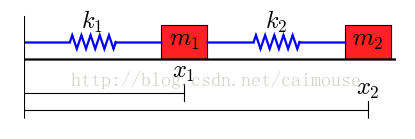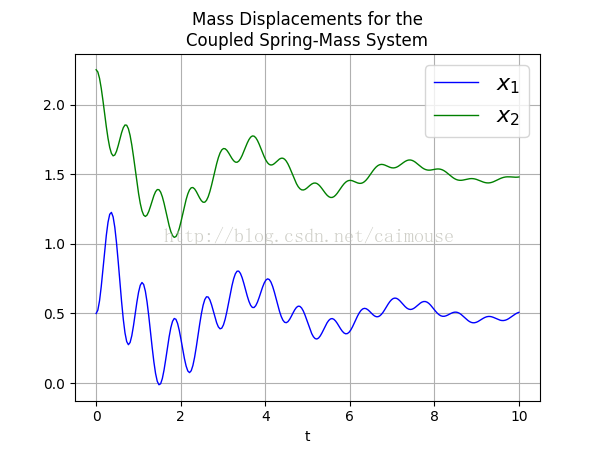前言
本文主要给大家介绍了关于利用python求解物理学中双弹簧质能系统的相关内容,分享出来供大家参考学习,下面话不多说了,来一起看看详细的介绍吧。
物理的模型如下:

在这个系统里有两个物体,它们的质量分别是m1和m2,被两个弹簧连接在一起,伸缩系统为k1和k2,左端固定。假定没有外力时,两个弹簧的长度为L1和L2。
由于两物体有重力,那么在平面上形成摩擦力,那么摩擦系数分别为b1和b2。所以可以把微分方程写成这样:

这是一个二阶的微分方程,为了使用python来求解,需要把它转换为一阶微分方程。所以引入下面两个变量:

这两个相当于运动的速度。通过运算可以改为这样:

这时可以线性方程改为向量数组的方式,就可以使用python定义了
代码如下:
|
1
2
3
4
5
6
7
8
9
10
11
12
13
14
15
16
17
18
19
20
21
22
23
24
25
26
27
28
29
30
31
32
33
34
35
36
37
38
39
40
41
42
43
44
45
46
47
48
49
50
51
52
53
54
55
56
57
58
59
60
61
62
63
64
65
66
67
68
69
70
|
# Use ODEINT to solve the differential equations defined by the vector field from scipy.integrate import odeint def vectorfield(w, t, p): """ Defines the differential equations for the coupled spring-mass system. Arguments: w : vector of the state variables: w = [x1,y1,x2,y2] t : time p : vector of the parameters: p = [m1,m2,k1,k2,L1,L2,b1,b2] """ x1, y1, x2, y2 = w m1, m2, k1, k2, L1, L2, b1, b2 = p # Create f = (x1',y1',x2',y2'): f = [y1, (-b1 * y1 - k1 * (x1 - L1) + k2 * (x2 - x1 - L2)) / m1, y2, (-b2 * y2 - k2 * (x2 - x1 - L2)) / m2] return f # Parameter values # Masses: m1 = 1.0m2 = 1.5# Spring constants k1 = 8.0k2 = 40.0# Natural lengths L1 = 0.5L2 = 1.0# Friction coefficients b1 = 0.8b2 = 0.5 # Initial conditions # x1 and x2 are the initial displacements; y1 and y2 are the initial velocities x1 = 0.5y1 = 0.0x2 = 2.25y2 = 0.0 # ODE solver parameters abserr = 1.0e-8relerr = 1.0e-6stoptime = 10.0numpoints = 250 # Create the time samples for the output of the ODE solver. # I use a large number of points, only because I want to make # a plot of the solution that looks nice. t = [stoptime * float(i) / (numpoints - 1) for i in range(numpoints)] # Pack up the parameters and initial conditions: p = [m1, m2, k1, k2, L1, L2, b1, b2] w0 = [x1, y1, x2, y2] # Call the ODE solver. wsol = odeint(vectorfield, w0, t, args=(p,), atol=abserr, rtol=relerr) with open('two_springs.dat', 'w') as f: # Print & save the solution. for t1, w1 in zip(t, wsol): out = '{0} {1} {2} {3} {4}\n'.format(t1, w1[0], w1[1], w1[2], w1[3]); print(out) f.write(out); |
在这里把结果输出到文件two_springs.dat,接着写一个程序来把数据显示成图片,就可以发表论文了,代码如下:
|
1
2
3
4
5
6
7
8
9
10
11
12
13
14
15
16
17
18
19
20
|
# Plot the solution that was generated from numpy import loadtxt from pylab import figure, plot, xlabel, grid, hold, legend, title, savefig from matplotlib.font_manager import FontProperties t, x1, xy, x2, y2 = loadtxt('two_springs.dat', unpack=True) figure(1, figsize=(6, 4.5)) xlabel('t') grid(True) lw = 1 plot(t, x1, 'b', linewidth=lw) plot(t, x2, 'g', linewidth=lw) legend((r'$x_1$', r'$x_2$'), prop=FontProperties(size=16)) title('Mass Displacements for the\nCoupled Spring-Mass System') savefig('two_springs.png', dpi=100) |
最后来查看一下输出的png图片如下:

总结
以上就是这篇文章的全部内容了,希望本文的内容对大家的学习或者工作具有一定的参考学习价值,如果有疑问大家可以留言交流,谢谢大家对服务器之家的支持。
原文链接:http://blog.csdn.net/caimouse/article/details/78070550










